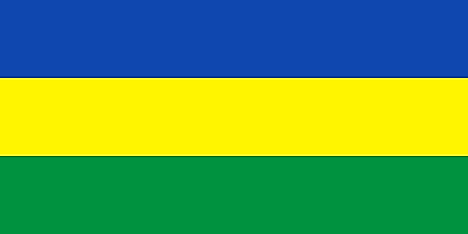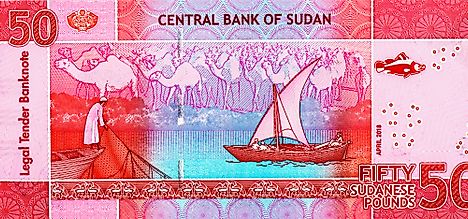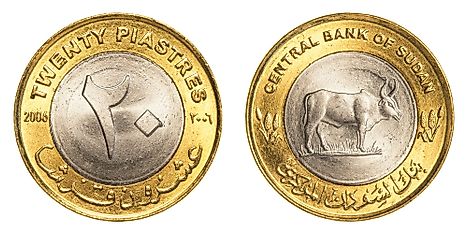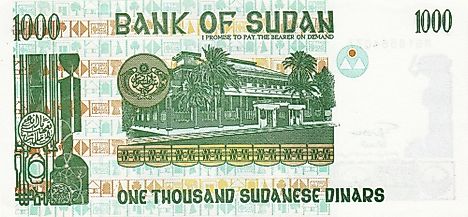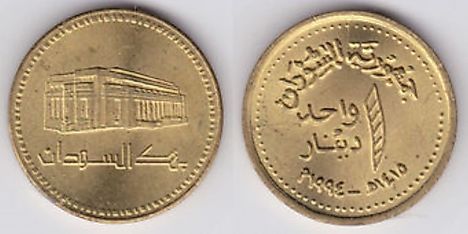Flags, Symbols & Currency of Sudan
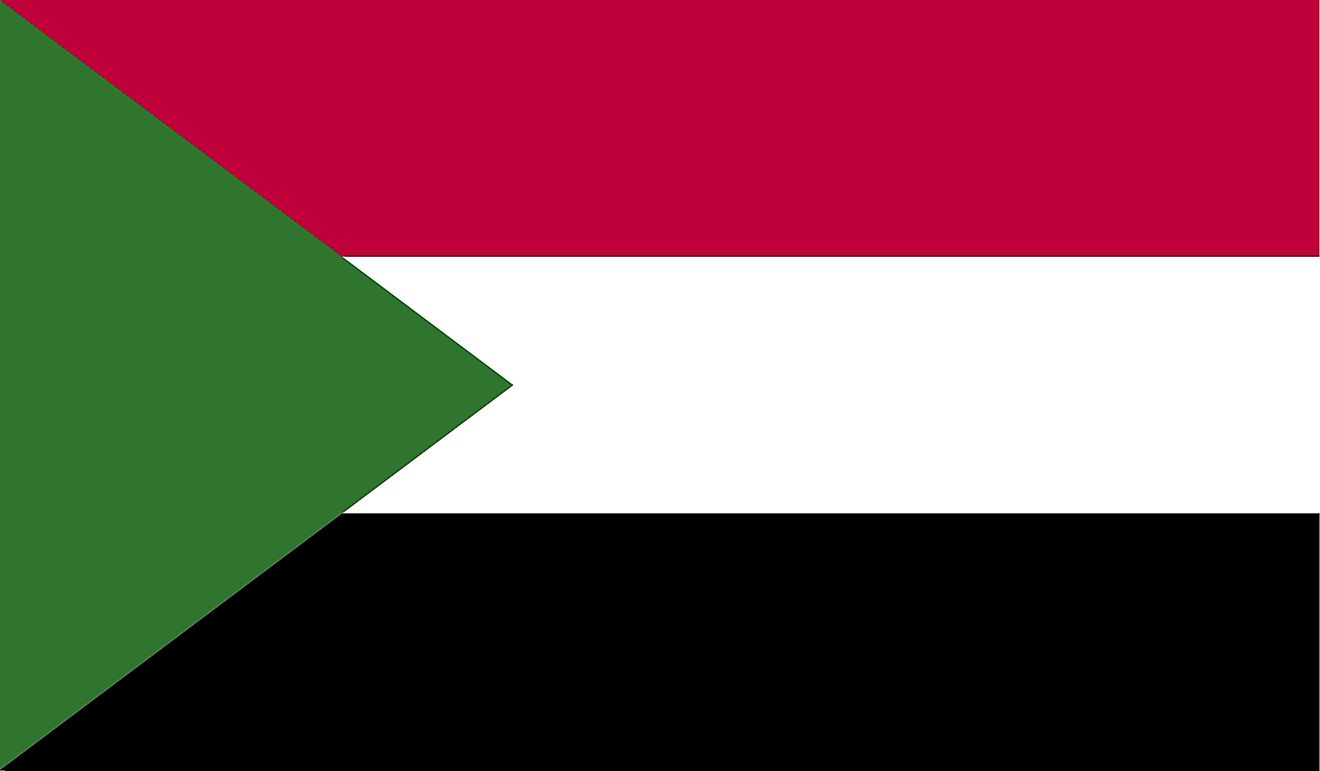
The National Flag of Sudan was officially adopted on May 20, 1970. The flag was designed by Abdel Rahman Ahmed Al-Jali.
The National Flag of Sudan features three equal horizontal bands of red (top), white, and black with a green isosceles triangle based on the hoist side. The red color stands for the country’s struggle for freedom. The white color represents peace, light, purity, and optimism. The black color represents the people of Sudan (in Arabic 'Sudan' means ‘Land of black people’). The green color symbolizes the Islamic religion, agriculture, and prosperity. Taken together, the national flag of Sudan symbolizes the unity of the nation. The flag has a width-to-length proportion ratio of 1:2.
History of the Flag of Sudan
In 1881, during the onset of the Mahdist War, Muhammad Ahmad appointed Abdallahi ibn Muhammad as a Khalifa and gave him a black flag. The black color of the current national is inspired by this history. From 1899-1956, Sudan was under the rule of Egypt and the United Kingdom, and during this time both the flags of Egypt and Sudan were flown together. During the colonial period, the British Governor-General had a rank flag in Sudan. The flag did not feature the coat of arms, but included a disk bearing the words "GOVERNOR GENERAL OF THE SUDAN." Sudan gained independence from Egypt and Britain on January 1, 1956. The new national flag adopted upon independence was a tricolor of horizontal stripes: blue (top), yellow (middle), and green (bottom). The blue color represented the River Nile, yellow symbolized the Sahara Desert, while green signified agriculture. The flag was used from 1956 until 1970. After a military revolt, the country was renamed the “Democratic Republic of Sudan” and adopted the current national flag of Sudan was adopted on May 20, 1970.
Symbols of Sudan
The National Coat of Arms of Sudan
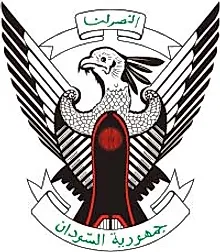
The current National Coat of Arms/Emblem of Sudan was adopted in 1985. It prominently features a secretary bird whose head is tilted to the right. The bird bears the shield of Muhammad Ahmad, who ruled Sudan briefly in the 19th century. A white scroll placed above the coat of arms bears the national motto, which is written in Arabic An-nasr lanā and translates to “Victory is ours”. A white scroll placed below the coat of arms bears the name of the country Jumhūriyat as-Sūdān ("Republic of the Sudan").
National Motto
An-nasr lanā (“Victory is ours”)
National Anthem
- Anthem Title: "Naḥnu Jund Allāh Jund al-Waṭan" ("We are the Soldiers of God, the Soldiers of our Homeland")
- Music Composer: Ahmed Morjan
- Lyricist: Ahmed Mohammed Saleh
- Date of Adoption: January 1, 1956
"Naḥnu Jund Allāh Jund al-Waṭan" ("We are the Soldiers of God, the Soldiers of our Homeland") is the national anthem of Sudan. The music of the anthem have been composed by Ahmed Morjan. The lyrics of the anthem have been penned by Ahmed Mohammed Saleh. The national anthem was adopted on January 1, 1956.
نحن جند الله جند الوطن (Arabic)
نحن جند الله جند الوطن
إن دعا داعي الفداء لم نخن
نتحدى الموت عند المحن
نشتري المجد بأغلى ثمن
هذه الأرض لنا
فليعيش سوداننا
علماً بين الأمم
يا بني السودان هذا رمزكم
يحمل العبء ويحمي أرضكم
"We are the Soldiers of God, the Soldiers of our Homeland"
We are God's soldiers, soldiers of homeland
If called for redemption, we did not betray
We defy death upon ordeals
We buy glory at the most expensive price
This land is ours
May our Sudan live, an edifice among the nations
O Sons of the Sudan this is your symbol,
carries the burden and protecting your land
The Currency of Sudan is the Sudanese pound
The current official currency of Sudan is the Sudanese pound (SD). It was introduced in 2011 after the secession of South Sudan. The Sudanese pound is made up of 100 subunits known as piastre or qirsh. The Central Bank of Sudan is the institution mandated to regulate the inflation and circulation of the Sudanese pound.
Coins
Currently, coins in denominations of 1, 5, 10, 20, 50 piasters, and 1 pound are in circulation.
Banknotes
Currently, banknotes are issued in 2-, 5-, 10-, 20-, 50-, 100-, 200-, 500-pound denominations. The banknotes have different pictures on their obverses and reverses, and these are usually items found in the country such as livestock, trees, and pottery.
Historical currencies of Sudan
Sudan had different types of currencies throughout its history including the Egyptian pound, the Sudanese dinar, and the Sudanese pound.
The Egyptian Pound:
The Egyptian pound was the first official currency in Sudan, which was introduced in the country while under the Anglo-Egyptian rule. The Egyptian pound was divided into 100 subunits known as qirush. The qirush was further subdivided into 40 paras. After the decimalization of the Egyptian pound in 1886, the para was abandoned and replaced by the millims which was exchanged for one qirush to 10 millims.
The Sudanese Pound (First Issue):
The Sudanese pound was the first official currency used in independent Sudan after gaining independence from Anglo-Egyptian rule in 1956. The new Sudanese pound was anchored to the US dollar between 1958 and 1978 where 1 Sudanese pound was equivalent to the US $2.87156. In the late 20th century, the currency went through a series of devaluations.
The Sudanese dinar:
In 1992, Sudan replaced the Sudanese pound with a new currency known as the Sudanese dinar at a rate of 1 Sudanese Dinar (SDD) to 10 Sudanese pounds. The Sudanese dinar was issued in coinage as well as banknotes. The banknotes were in different denominations, the largest of which being the 10,000-dinar banknote and the smallest being the 100-dinar banknote. Smaller denominations of the banknotes (50-, 25-, 10-, and 5-dinar banknotes) were originally issued but were later withdrawn by the Central Bank of Sudan. The coinage denomination ranged between the 50-dinar coin and the 1-dinar coin. The Central Bank of Sudan also issued coinage of smaller denominations including the half-dinar and quarter-dinar coins, but these were rarely used. The Sudanese dinar was recognized as Sudan’s official currency between 1992 and 2007, but during this period the southern part of the country was agitating for secession from the north and still recognized the Sudanese Pound as the official currency.
The Sudanese Pound (Second Issue):
After the warring factions in Sudan reached an understanding during the Comprehensive Peace Agreement, the Central Bank of Sudan was directed to issue a new currency, the Sudanese pound, to be used in the country. The Sudanese pound was therefore introduced in 2007 and replaced the Sudanese dinar at a rate of 1 Sudanese pound to 100 Sudanese dinars. The second issue of the Sudanese pound was the country’s official currency from 2007 until 2011 when South Sudan became an independent country.
The Sudanese Pound (Third Issue):
After the succession of South Sudan from Sudan in 2011, a third Sudanese pound was issued. It has remained the official currency of Sudan to this day.
